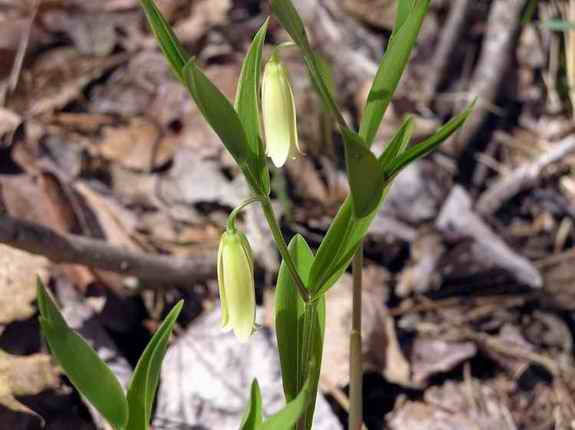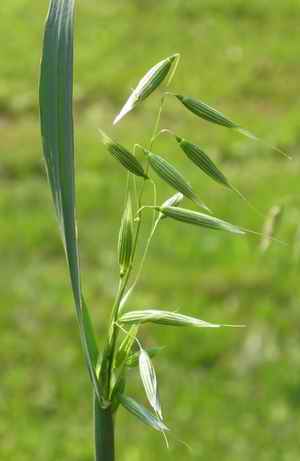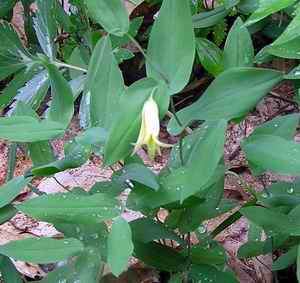|
Return to Hiker's Notebook Home Page
Common Name: Bellwort, Sessile Bellwort, Wild Oats, Merrybell, Haybell, Straw Flower, Wood Daffodil - The flowers of the bellwort are named for the bell-like shape of the flower; wort is from the Old English word wyrt that meant root or herb and is generally appended as a suffix for any plant that was used for medicinal purposes.
Scientific Name: Uvularia sessilifolia - The generic name is derived from uvula, the small fleshy protuberance from the soft palate above the back of the tongue, as the flower has this appearance (uvula is a diminutive of the Latin word uva which means grape, the uvula having the appearance of a small hanging grape). The species name is from the Latin sessilis folium which means sessile leaf. Sessile means that the leaves are attached directly to the main stem without a petiole.
According to the Doctrine of Signatures, the shape of the bellwort was a sign of its purpose, a means by which divine intent was communicated to mankind. As is made clear from the name of the genus, the shape was thought to most resemble the uvula at the back of the throat. It was therefore made into a tea that was used in the treatment of sore throats, inflamed gums, coughs and other ailments of the oral cavity. The taste was characterized as pungent and the texture mucilaginous. There is no evidence that this had any ameliorative effect; the power of suggestion presumably resulted in some perceived improvement as its use for this purpose persisted over some significant period of time.
The use of the Uvularia genus plants for the treatment of illness by early colonists had its origins, at least in part, in their use by Native Americans for a variety of medical conditions beyond that as a tea for sore throat. The Haudenosaunee Indians (more commonly known as the Iroquois) made a poultice of the roots to treat boils, and as a vulnerary to heal wounds, ulcers and broken bones; the roots were taken internally as an additional measure to promote the knitting of bone fractures. Other uses included treatment for diarrhea, blood purification, as an infusion for backache, as a wash to treat sore eyes and as emollient for sore muscles. The Menomini also used it to reduce swelling.
Bellwort plants were also eaten as part of the diet of both Native Americans and early colonists. In 1785, the botanist Manassah Cutler noted that "�the young shoots may be eaten as asparagus. The roots are nutritious, and are used in diet-drinks." The part of the plant that was consumed was actually the rhizome, a horizontal, underground root-like stem that is usually thickened due to the storage of accumulated food. The Cherokee Indians either fried the roots in fat or ate them raw. It is clear from the many common names and purported medicinal properties of the bellwort that it is widely distributed and readily recognized. The name wild oats attests to this, nodding of the bellwort flowers calling to mind the nodding of oat grains (right). The ubiquity of
Uvularia species all with the same basic bell-shaped flower has also
contributed to its importance in folk herbal remedies. The large-flowered
bellwort (U. grandiflora) has large yellow flowers and can grow to two
feet in height. Other species include the mountain bellwort (U. pudica),
the Florida bellwort (U. floridana) and the perfoliate bellwort (U.
perfoliata). The latter has the somewhat unusual arrangement of perfoliate
leaves; the leaves have a base surrounding the stem as a means of support so
that it appears as if the stem penetrated the leaves (below).
|


